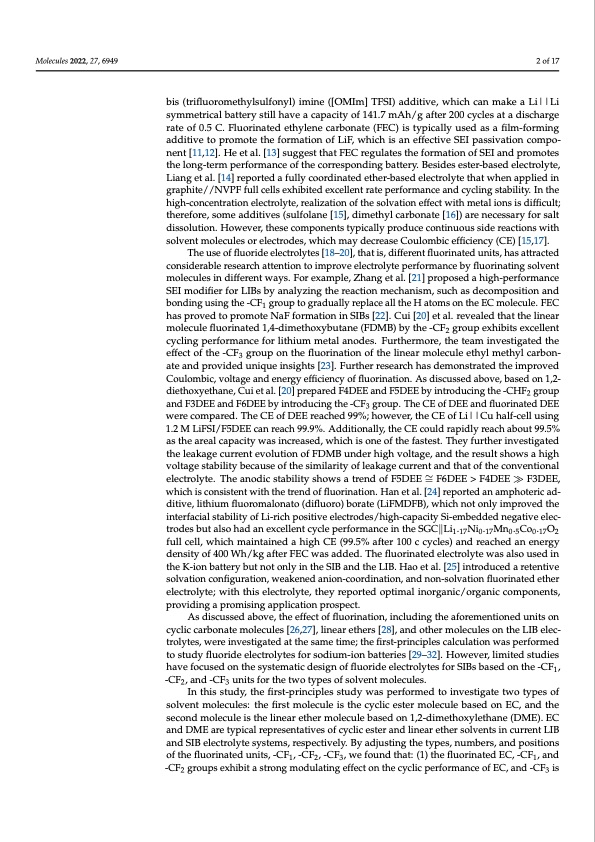
PDF Publication Title:
Text from PDF Page: 002
Molecules 2022, 27, 6949 2 of 17 bis (trifluoromethylsulfonyl) imine ([OMIm] TFSI) additive, which can make a Li||Li symmetrical battery still have a capacity of 141.7 mAh/g after 200 cycles at a discharge rate of 0.5 C. Fluorinated ethylene carbonate (FEC) is typically used as a film-forming additive to promote the formation of LiF, which is an effective SEI passivation compo- nent [11,12]. He et al. [13] suggest that FEC regulates the formation of SEI and promotes the long-term performance of the corresponding battery. Besides ester-based electrolyte, Liang et al. [14] reported a fully coordinated ether-based electrolyte that when applied in graphite//NVPF full cells exhibited excellent rate performance and cycling stability. In the high-concentration electrolyte, realization of the solvation effect with metal ions is difficult; therefore, some additives (sulfolane [15], dimethyl carbonate [16]) are necessary for salt dissolution. However, these components typically produce continuous side reactions with solvent molecules or electrodes, which may decrease Coulombic efficiency (CE) [15,17]. The use of fluoride electrolytes [18–20], that is, different fluorinated units, has attracted considerable research attention to improve electrolyte performance by fluorinating solvent molecules in different ways. For example, Zhang et al. [21] proposed a high-performance SEI modifier for LIBs by analyzing the reaction mechanism, such as decomposition and bonding using the -CF1 group to gradually replace all the H atoms on the EC molecule. FEC has proved to promote NaF formation in SIBs [22]. Cui [20] et al. revealed that the linear molecule fluorinated 1,4-dimethoxybutane (FDMB) by the -CF2 group exhibits excellent cycling performance for lithium metal anodes. Furthermore, the team investigated the effect of the -CF3 group on the fluorination of the linear molecule ethyl methyl carbon- ate and provided unique insights [23]. Further research has demonstrated the improved Coulombic, voltage and energy efficiency of fluorination. As discussed above, based on 1,2- diethoxyethane, Cui et al. [20] prepared F4DEE and F5DEE by introducing the -CHF2 group and F3DEE and F6DEE by introducing the -CF3 group. The CE of DEE and fluorinated DEE were compared. The CE of DEE reached 99%; however, the CE of Li||Cu half-cell using 1.2 M LiFSI/F5DEE can reach 99.9%. Additionally, the CE could rapidly reach about 99.5% as the areal capacity was increased, which is one of the fastest. They further investigated the leakage current evolution of FDMB under high voltage, and the result shows a high voltage stability because of the similarity of leakage current and that of the conventional electrolyte. The anodic stability shows a trend of F5DEE ∼= F6DEE > F4DEE ≫ F3DEE, which is consistent with the trend of fluorination. Han et al. [24] reported an amphoteric ad- ditive, lithium fluoromalonato (difluoro) borate (LiFMDFB), which not only improved the interfacial stability of Li-rich positive electrodes/high-capacity Si-embedded negative elec- trodes but also had an excellent cycle performance in the SGC∥Li1.17Ni0.17Mn0.5Co0.17O2 full cell, which maintained a high CE (99.5% after 100 c cycles) and reached an energy density of 400 Wh/kg after FEC was added. The fluorinated electrolyte was also used in the K-ion battery but not only in the SIB and the LIB. Hao et al. [25] introduced a retentive solvation configuration, weakened anion-coordination, and non-solvation fluorinated ether electrolyte; with this electrolyte, they reported optimal inorganic/organic components, providing a promising application prospect. As discussed above, the effect of fluorination, including the aforementioned units on cyclic carbonate molecules [26,27], linear ethers [28], and other molecules on the LIB elec- trolytes, were investigated at the same time; the first-principles calculation was performed to study fluoride electrolytes for sodium-ion batteries [29–32]. However, limited studies have focused on the systematic design of fluoride electrolytes for SIBs based on the -CF1, -CF2, and -CF3 units for the two types of solvent molecules. In this study, the first-principles study was performed to investigate two types of solvent molecules: the first molecule is the cyclic ester molecule based on EC, and the second molecule is the linear ether molecule based on 1,2-dimethoxylethane (DME). EC and DME are typical representatives of cyclic ester and linear ether solvents in current LIB and SIB electrolyte systems, respectively. By adjusting the types, numbers, and positions of the fluorinated units, -CF1, -CF2, -CF3, we found that: (1) the fluorinated EC, -CF1, and -CF2 groups exhibit a strong modulating effect on the cyclic performance of EC, and -CF3 isPDF Image | First-Principles-Based Optimized Design of Fluoride Electrolytes

PDF Search Title:
First-Principles-Based Optimized Design of Fluoride ElectrolytesOriginal File Name Searched:
molecules-27-06949.pdfDIY PDF Search: Google It | Yahoo | Bing
Salgenx Redox Flow Battery Technology: Salt water flow battery technology with low cost and great energy density that can be used for power storage and thermal storage. Let us de-risk your production using our license. Our aqueous flow battery is less cost than Tesla Megapack and available faster. Redox flow battery. No membrane needed like with Vanadium, or Bromine. Salgenx flow battery
| CONTACT TEL: 608-238-6001 Email: greg@salgenx.com | RSS | AMP |